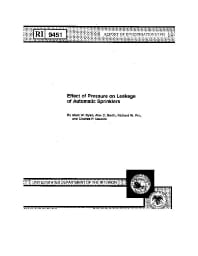Mining Publication: Effect of Pressure on Leakage of Automatic Sprinklers
Original creation date: January 1993
Authors: MW Ryan, AC Smith, RW Pro, CP Lazzara
NIOSHTIC2 Number: 20023179
U.S. Department of the Interior, Bureau of Mines, Report of Investigations 9451, 1993:1-13
The U.S. Bureau of Mines conducted a study to determine if commercially available automatic sprinklers could withstand the high static pressures in deep underground coal mines without leaking and if exposure to the mine environment affected their leak pressures. New sprinklers and sprinklers exposed to the mine environment were subjected to increasing pressures until leakage occurred. The average leak pressures of the new sprinklers ranged from 640 to 2,300 psig and were significantly different for sprinklers from different manufacturers and for different types of sprinklers. Generally, standard-response sprinklers withstood higher pressures than fast-response sprinklers. The results indicated that most commercially available sprinklers would withstand the high static pressures in deep underground coal mines; however, they would not provide the same reliability and safety factor as sprinklers used aboveground at or below their rated pressure of 175 psig. The average leak pressures of the sprinklers exposed to the mine environment ranged from 740 to 1,180 psig. The mine environment affected the ability of 66% of the sprinklers to withstand high static pressures. New sprinklers were also evaluated at pressures of at least 500 psig for 30 days to determine their ability to withstand long-term exposure to high static pressures; no leakage was observed.

NIOSHTIC2 Number: 20023179
U.S. Department of the Interior, Bureau of Mines, Report of Investigations 9451, 1993:1-13
- A Computer Software Program that Estimates Air Quantity Requirements in Large Opening Stone Mines
- Detonation Wave Propagation in Underground Mine Entries
- Performance and Safety Investigation of Emergency Backup Batteries and Battery Charging Systems for Underground Mining Applications
- Practical Risk Assessment Guidelines for Identifying, Assessing, and Mitigating Stored Energy Hazards in Underground Coal Mines During and After a Mine Emergency
- Refuge Alternatives in Underground Coal Mines
- Relationship Between Radiated Seismic Energy and Explosive Pressure for Controlled Methane and Coal Dust Explosions in an Underground Mine
- Safe and Economical Inerting of Sealed Mine Areas
- Technology News 514 - The Air Quantity Estimator (AQE): A New Computer Software Tool for Large-opening Mine Ventilation Planning
- Ultra-Low Frequency Through-the-Earth Communication Technology
- Wireless Mesh Mine Communication System